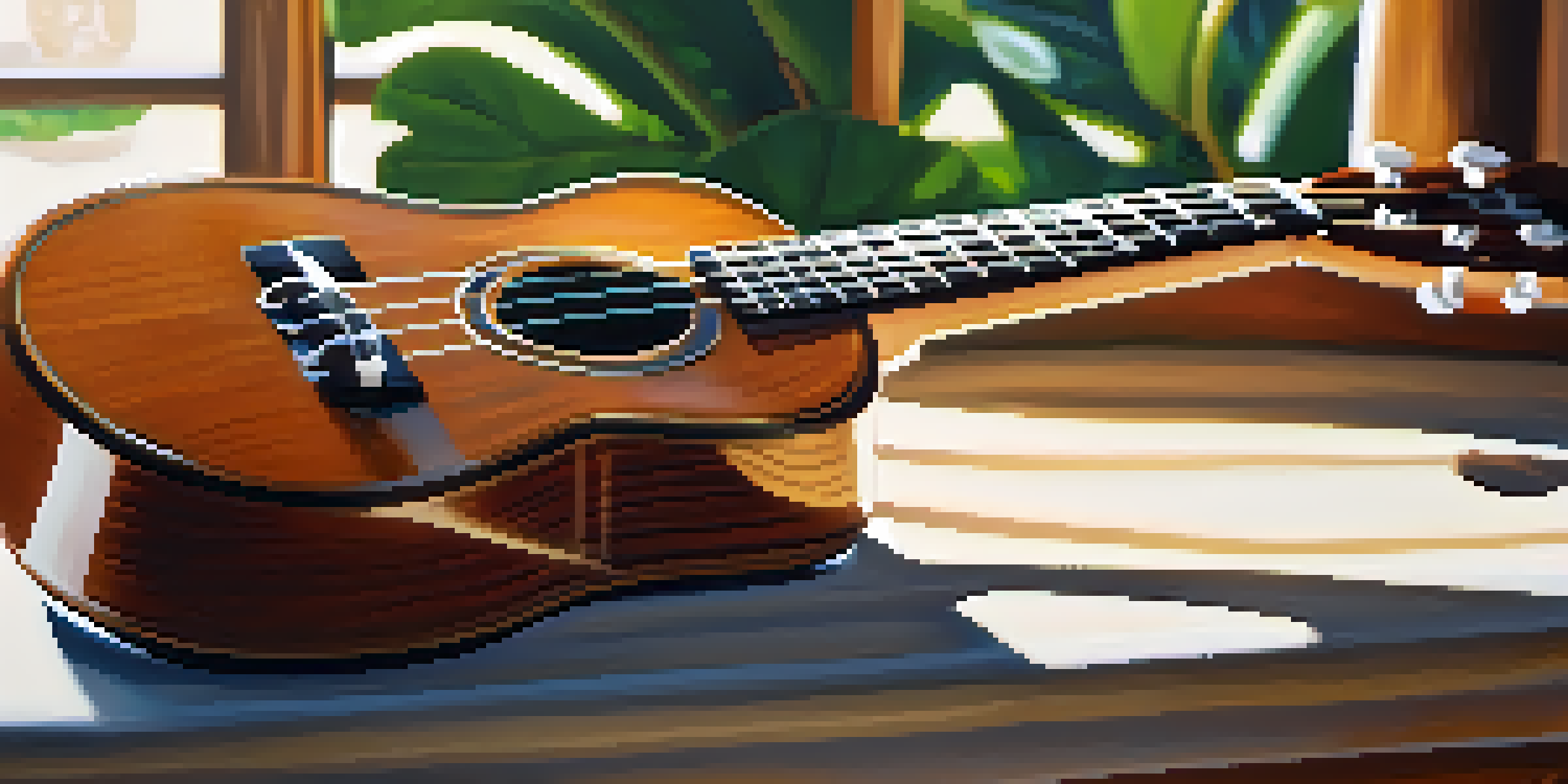Capturing Ukulele Sound: Placement and Techniques

Understanding the Ukulele's Unique Sound Characteristics
The ukulele boasts a bright, cheerful tone that can vary widely between different models. This distinct sound comes from its smaller body size and the materials used in its construction, influencing how notes resonate. Understanding these characteristics is crucial for any recording session, as it can guide your approach to mic placement and recording techniques.
The ukulele is a small instrument with a big heart.
For instance, a concert ukulele may produce a fuller sound compared to a soprano, which is often sharper. Recognizing these differences allows you to harness the unique qualities of each instrument, ensuring that the sound you capture reflects its true essence. Thus, before you even set up your recording gear, take a moment to appreciate the nuances of your specific ukulele.
In essence, knowing your instrument is the first step towards achieving an authentic sound. This foundational knowledge will not only enhance your recordings but also deepen your connection with the music you create.
Choosing the Right Microphone for Ukulele Recording
Selecting the right microphone is essential for capturing the sweet tones of the ukulele. Generally, condenser microphones are preferred due to their sensitivity and ability to capture the subtle nuances of acoustic instruments. For a more natural sound, consider using a small diaphragm condenser, which excels at picking up the high frequencies typical of a ukulele.

Alternatively, dynamic microphones can also be used, especially in live settings where durability and feedback rejection are important. Each type of microphone brings its own flavor to the recording, so experimenting with different options can yield delightful results. Don’t hesitate to try out both types to see which best suits your style.
Understand Ukulele Sound Characteristics
The unique sound of a ukulele varies by model and construction, influencing recording techniques like mic placement.
Ultimately, the microphone you choose will significantly impact the final sound. By understanding the strengths of each type, you can make an informed decision that complements your ukulele's unique voice.
Optimal Mic Placement: Finding the Sweet Spot
Once you have your microphone selected, the next step is finding the ideal placement. A common starting point is to position the mic approximately 6 to 12 inches away from the ukulele’s sound hole. This distance allows you to capture the instrument's warmth without overwhelming it with low frequencies.
Recording is more than just capturing sound; it’s about creating an experience.
You can also experiment with angles and distances to discover the sweet spot that captures the ukulele's tone best. For example, angling the mic slightly away from the sound hole can help to reduce unwanted boominess while still picking up the instrument's brightness. Remember, each ukulele is different, so what works for one might not work for another.
Finding the right mic placement is akin to tuning into a radio station; once you hit the right frequency, everything sounds clearer and more enjoyable. Don't be afraid to move things around until you achieve the sound you're after!
Room Acoustics: The Impact on Ukulele Sound Quality
The environment where you record plays a significant role in the quality of your sound. A room with too many hard surfaces can create unwanted reflections, leading to a harsh sound. To achieve the best results, consider recording in a space with soft furnishings that can absorb sound, minimizing echoes and reverberation.
If you don’t have access to a perfectly acoustically treated room, you can make some simple adjustments. Adding carpets, curtains, or even using blankets can help soften the space and create a more controlled sound environment. This way, you can focus on capturing the ukulele’s rich tones without interference from the room.
Choose the Right Microphone
Selecting the appropriate microphone, such as a condenser, is crucial for capturing the subtle tones of the ukulele.
Ultimately, paying attention to your recording space is just as important as your microphone choices. A well-chosen environment can enhance the clarity and warmth of your ukulele recordings, making them truly shine.
Using Multiple Microphones for a Richer Sound
To create a fuller, more dynamic recording, consider using multiple microphones. This technique allows you to capture the ukulele from different angles, adding depth and dimension to the sound. A common method is to use one mic focused on the sound hole and another positioned near the fretboard to capture the brightness of the strings.
By blending the two recordings, you can achieve a more balanced and rich sound, much like layering different colors on a canvas. This approach gives you greater control over the final mix, allowing you to highlight the aspects of the ukulele’s tone that resonate with your musical vision.
Experimenting with multiple mics can be a game-changer, transforming a simple recording into a vibrant, engaging piece of music. Just remember to pay attention to phase issues that can arise when using multiple sources, ensuring your sound remains cohesive.
Capturing Performance: Techniques for Best Results
When recording ukulele, it’s essential to consider the performance aspect as well. Encourage musicians to play naturally, as tense playing can lead to a less authentic sound. Capturing the essence of a live performance often means allowing for a bit of spontaneity and emotion, which can breathe life into the recording.
Using a direct input (DI) along with miking the instrument can provide a clean signal while preserving the warmth of the acoustic sound. This dual approach allows for more flexibility during mixing, giving you options to blend the best of both worlds.
Optimize Recording Environment
Room acoustics significantly affect sound quality, so soft furnishings can help absorb unwanted reflections during recordings.
Ultimately, the goal is to create a recording that feels alive and engaging. By focusing on the performance and allowing the musician's personality to shine, you'll end up with a track that resonates with listeners on a deeper level.
Post-Production: Enhancing Your Ukulele Recordings
After capturing your ukulele recordings, the post-production phase becomes crucial for enhancing the final sound. Start with basic edits, such as trimming unwanted sections and adjusting levels to ensure a balanced mix. This is also the time to apply EQ, helping to emphasize the ukulele’s bright characteristics while cutting any muddiness.
Adding reverb or delay effects can further enrich the sound, creating a sense of space and depth. However, it’s important to use these effects judiciously; too much can overshadow the instrument's natural charm. Aim for a sonic landscape that complements the ukulele without drowning it out.

In the end, post-production is where your recordings come to life. By carefully refining each track, you can transform a great performance into an exceptional listening experience.